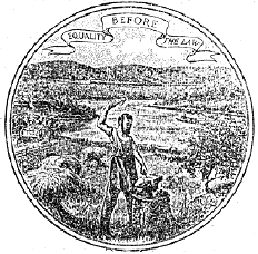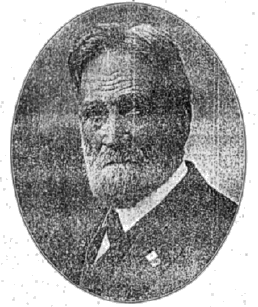|
(These obituaries are compiled largely
from death notices printed in newspapers which are received
and kept on file by the Historical Society. While the
sketches have been carefully edited, it has been impossible
to avoid and correct all inaccuracies The lives of some
subjects of the obituaries were of unusual public interest,
and in such cases the sketches have been duly amplified.
Statements of fact, particularly those which are of record,
have been verified as far as practicable. Obviously, it is,
very desirable that these records which will always be used.
for reference, should be correct, and surviving relatives
and editors of local newspapers should carefully cooperate
in preventing errors.)
Mrs. Phoebe Ellen Young Stafford, born in
Mills county, Iowa, August 11th, 1863, died December 25th at
Clarinda, Iowa; came with parents to Cass county in
1856.
Mrs. Elizabeth Lebs Schmid, wife of Jacob
Schmid, Platte county, resident of Nebraska since 1867, died
January 1st.
Mrs. Marie Antoinette Newberry Filley,
resident of Auburn, Nebraska, in the early sixties, died in
Portland, Oregon, January 1st.
Gus B. Speice, born in Columbus, Nebraska,
July 16, 1864, died January 4th; son of Charles A. and
Katherine Becker Speice, pioneers of Platte county; was
active in business and political life; held the offices of
clerk of the district court, mayor, and city treasurer.
Mrs. Sarah Waite, Beatrice, died January
5th; settled at Brownville, Nebraska, in October, 1867.
John Rhoden, Dixon county, pioneer of
1856, died January 5th.
Mrs. Martha Nicholson Thorp, Nebraska
City, died January 6th; married to Edwin F. Thorp, October
19, 1862; in 1863 moved to Nebraska City.
William Henry Kerns, resident of Nebraska
since 1867, died in Table Rock, January 6th.
James T. Munson, resident of Lancaster
county since 1866, died January 8th.
Mrs. Rosina Uhlig, Falls City, died
January 8th; settled in Nemaha county in 1857.
Mrs. Achte Margaretha Neemann, resident of
Otoe county since 1862, died January 9th.
Aaron Wilson, pioneer of Burt county in
1866, died in Tacoma, Washington, January 9th.
Mrs. Casper E. Yost, resident of Omaha
since 1866, died at Long Beach, Cal., about January
10th.
Mr. Yost died November 22, 1920. He was
the principal founder of the Nebraska Telephone Company, and
when he retired from business, in 1919, he was president of
the company and also of the Iowa Telephone Company and the
Northwestern Telephone Exchange Company.
Mrs. Bridget Bourke, resident of Nemaha
county since 1862, died January 10th.
Mrs. Mary Costin a resident of Nebraska
since 1857, died at her home near Gothenburg, January
11th.
James McKenna, 85 years old, resident of
Omaha since 1866, died January 11th.
Mrs. Anna Marie Ramseyer, daughter of Rev.
William Hamilton, noted missionary to the Indians, died
about January 11th, in Missouri Valley, Iowa.
Father Hamilton, as he was commonly
called, was a missionary among Indians of the
west-of-the-Missouri plains during the larger part of his
life. He was a teacher at the Sauk and Fox mission, Great
Nemaha agency, from 1841 to 1853, when he became
superintendent of the Crow and Omaha mission on separate
reservations, in (sic) mained until these tribes were placed
on separate reservations, in 1855. He was superintendent of
the Omaha mission under the patronage of the Presbyterian
Board of Foreign Missions, from July, 1867, until 1869, when
the mission was superseded by the new policy through which
the Indian agencies were put under control of the several
religious denominations, those in Nebraska falling to the
Society of Friends.
John S. Ellison, a farmer for fifty-five
years near Liberty, Nebraska, died January 13th.
Mrs. Mary Buskirk, resident of Cass
county, near Murdock for fifty-three years, died January
15th.
Claudius P. Douglass died at his home near
Melba, Platte county, January 16th; freighted from Nebraska
City to Fort Laramie in 1866; settled permanently in
Nebraska in 1883.
Joseph William Martin, born in Pawnee
county, Nebraska, November 8, 1867, died January 18th;
graduated from the college of medicine of the University of
Nebraska in 1903.
Peter Freese died in Nebraska City January
19th; said to have been fireman on the first train that ran
from Nebraska City to Lincoln on the Midland Pacific
railroad; was an engineer in the employ of that railroad for
many years; and a resident of Nebraska from 1866.
Barney Mullen, aged eighty-three years,
resident of Nebraska since 1860, died at Shreveport,
Louisiana, January 23rd; enlisted for service in the Civil
War in the Sixth Illinois Cavalry, Company C, September 3,
1861; was mustered out at Nashville, December 16, 1865.
After the war he resumed farming near Stella and left an
estate of 1080 acres in Richardson county.
Mrs. Hannah M. Beatty, resident of Johnson
county since 1866, died January 24th.
Peter E. Iler, resident of Omaha since
1866, died January 25th; engaged in the wholesale liquor
business until 1902; president of the Willow Springs
distillery and leader in anti-prohibition movements, was one
of the promoters of the Omaha Stock Yards company; organized
with others the South Omaha Land company; built many
substantial buildings in Omaha among which was the Iler
Grand Hotel.
|
Mr. Iler was a very influential citizen of Omaha for
about forty years.
Enoch W. Bline died January 26th in Omaha;
crossed the plains in 1849; resided permanently in Nebraska
since 1866.
Eli Plummer, Lincoln, died January 27th;
born November 26, 1835; settled in Plattsmouth in March
1863; engaged in wholesale grocery business in Lincoln in
1879; had a large part in the growth and development of
Lincoln.
Mrs. Emily Jane Conover Deweber, resident
of Nebraska since 1859, died at her home near Pawnee City
January 28th.
Mrs. Margaret Jane Strop Wise died at
Heartwell, January 28th; came to Nebraska in 1867.
Mrs. Martha Jane Brown Selby, resident of
Nebraska since 1865, died January 28th in Wauneta.
Augustus Lockner, resident of Nebraska
since 1866 died in Omaha January 29th. Mr. Lockner was a
soldier of the Civil War and also aided in guarding General
Dodge and his party against Indians during the building of
the Union Pacific railroad.
John Stevenson, resident of Florence and
Omaha since 1856; died January 29th; born in Scotland; came
with his father, Alexander Stevenson, to Florence in July
1856.
Henry Schmidt, a member of the firm of
Fred Schmidt and Brother, and a resident of Lancaster county
for over fifty years, died January 29th.
William G. Hall, born in Nebraska City,
July 23, 1856, son of C. C. and Susan Hail, died January
30th in Omaha.
Mrs. Elizabeth Catherine McCorkle Wiles,
who settled in Cass county in 1856, died January 31st. She
was the mother of ten sons, and four daughters.
Mrs. William Daily, resident of Auburn and
Nemaha county since 1861; died February 5th. other
(sic) of Mrs. A. K Goudy, deputy state superintendent
1891-95.
Elmer E. Davis, native of Colfax county,
born November 16, 1860, died February 5th.
W. L. E. Green, Independent, died February
5th; resided in Nebraska for fifty-four years.
Miss Margaret L. McCheane, Omaha, died
February 5th at Long Beach, California; came to Omaha with
her parents in 1857; was the third woman employed by the
Union Pacific railroad company, starting in 1873 and was
retired with a pension in 1909.
Mrs. Johanna Haney, resident of Platte
county in 1864, died February 6th at her home near
Richland.
V. W. Darling, ninety-three years old, a
resident of Nebraska for sixty-five years, died in Auburn,
February 7th.
Milton M. Harney, resident of Burt county
since 1867, died February 10th; in 1862 enlisted in the 2nd
Nebraska Cavalry and served on the western frontier to
protect the settlers from Indian depredations.
Richard Dunning, born in Richardson
county, July 3, 1859, died at his home in Indianola,
February 11th.
Daniel D. Johnson, Scottsbluff, died
February 11th; settled in Cass county in 1867; born in
Crawford, Pennsylvania, April 20, 1843; removed to Iowa and
enlisted for service in the Civil War in Company A 29th Iowa
Volunteers.
George W. Brown, a resident of Otoe county
before 1860, died February 15th.
Mrs. Mary Cummings, eighty-six years old,
resident of Omaha since 1866, died February 15th.
Mrs. Lucy Helen Glover Tower, resident of
Nebraska since 1858, died at her home in Lincoln, February
17th.
William Blair, a soldier of the Civil War,
died February 18th, in Brainard where he had lived since
1867.
Michael Brannen died in Auburn, February
21; settled in Nebraska City in 1855; enlisted for service
in the Civil War in a Missouri regiment of infantry; at the
close of the war returned to Nebraska, settling at St.
Deroin, later lived at Shubert. Mrs. Brannen died on
February 26th, She had endured all the hardships of pioneer
life on the western frontier and was with her husband at the
time he was campaigning with the Union army in Kansas, one
child being born at that time.
Mrs. W. Albert Heikes, resident of Dakota
City since 1867, died February 21st.
James Firmon Harris, soldier of the Civil
War, resident of Nebraska since 1866, died in Hildreth,
February 22nd.
William H. Turner, who freighted between
Omaha and Denver in the sixties and helped to build the
Union Pacific railroad through Wyoming, died in Fremont
February 27th; came to Nebraska first in 1869.
Mrs. Cornelia Olson, who settled on a farm
five miles south of Herman in 1866, where she had since
resided, died March 2.
T. M. Wimberly of University Place,
resident of Nebraska for almost sixty years, died March
7th.
Lewis H. Laflin, soldier of the Civil War,
died at his farm residence near Crab Orchard, March 7th,
where he had settled in May 1857: served three years in
Company I, First Regiment Nebraska Volunteers (afterward
First Nebraska Cavalry and First Regiment Nebraska Veteran
Volunteers); member of the Nebraska House of Representatives
of 1873, and held many offices of responsibility in Johnson
county.
August Stark, pioneer Cuming county in
1863, died near Bennet, March 8th.
Horace Dutton, Dakota City, resident of
Nebraska for sixty-five years, died March 8th; was a member
of Company D, Fifth Iowa Cavalry in the Civil War; was noted
for the fact that although he had had four years active
service in the war he was never known to tell a war
story.
|


